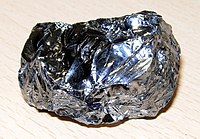
Photo from wikipedia
Fe–N–C catalysts offer excellent performance for the oxygen reduction reaction (ORR) in alkaline media. With a view toward boosting the intrinsic ORR activity of Fe single‐atom sites in Fe–N–C catalysts,… Click to show full abstract
Fe–N–C catalysts offer excellent performance for the oxygen reduction reaction (ORR) in alkaline media. With a view toward boosting the intrinsic ORR activity of Fe single‐atom sites in Fe–N–C catalysts, fine‐tuning the local coordination of the Fe sites to optimize the binding energies of ORR intermediates is imperative. Herein, a porous FeN4–O–NCR electrocatalyst rich in catalytically accessible FeN4–O sites (wherein the Fe single atoms are coordinated to four in‐plane nitrogen atoms and one subsurface axial oxygen atom) supported on N‐doped carbon nanorods (NCR) is reported. Fe K‐edge X‐ray absorption spectroscopy (XAS) verifies the presence of FeN4–O active sites in FeN4–O–NCR, while density functional theory calculations reveal that the FeN4–O coordination offers a lower energy and more selective 4‐electron/4‐proton ORR pathway compared to traditional FeN4 sites. Electrochemical tests validate the outstanding intrinsic activity of FeN4–O–NCR for alkaline ORR, outperforming Pt/C and almost all other M–N–C catalysts reported to date. A primary zinc–air battery constructed using FeN4–O–NCR delivers a peak power density of 214.2 mW cm−2 at a current density of 334.1 mA cm−2, highlighting the benefits of optimizing the local coordination of iron single atoms.
Journal Title: Advanced Materials
Year Published: 2022
Link to full text (if available)
Share on Social Media: Sign Up to like & get
recommendations!